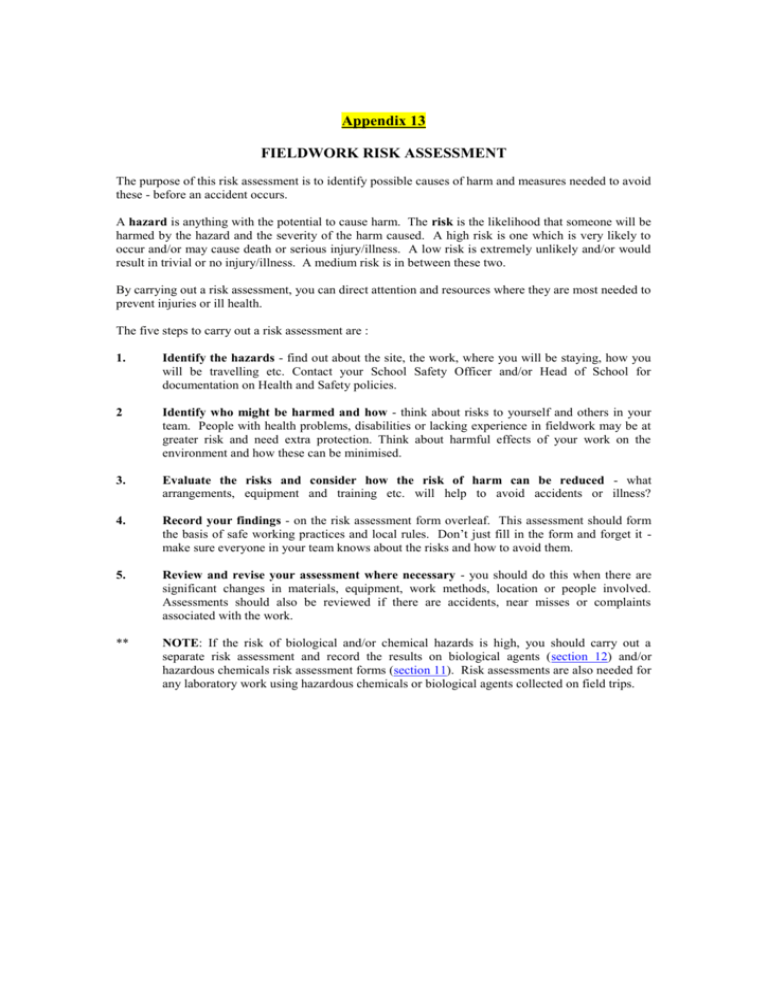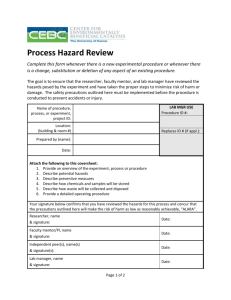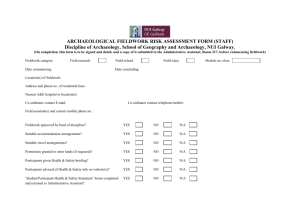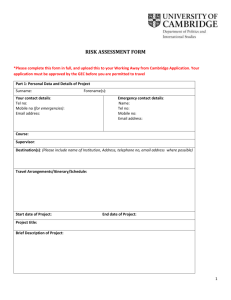Appendix 13
advertisement

Appendix 13 FIELDWORK RISK ASSESSMENT The purpose of this risk assessment is to identify possible causes of harm and measures needed to avoid these - before an accident occurs. A hazard is anything with the potential to cause harm. The risk is the likelihood that someone will be harmed by the hazard and the severity of the harm caused. A high risk is one which is very likely to occur and/or may cause death or serious injury/illness. A low risk is extremely unlikely and/or would result in trivial or no injury/illness. A medium risk is in between these two. By carrying out a risk assessment, you can direct attention and resources where they are most needed to prevent injuries or ill health. The five steps to carry out a risk assessment are : 1. Identify the hazards - find out about the site, the work, where you will be staying, how you will be travelling etc. Contact your School Safety Officer and/or Head of School for documentation on Health and Safety policies. 2 Identify who might be harmed and how - think about risks to yourself and others in your team. People with health problems, disabilities or lacking experience in fieldwork may be at greater risk and need extra protection. Think about harmful effects of your work on the environment and how these can be minimised. 3. Evaluate the risks and consider how the risk of harm can be reduced - what arrangements, equipment and training etc. will help to avoid accidents or illness? 4. Record your findings - on the risk assessment form overleaf. This assessment should form the basis of safe working practices and local rules. Don’t just fill in the form and forget it make sure everyone in your team knows about the risks and how to avoid them. 5. Review and revise your assessment where necessary - you should do this when there are significant changes in materials, equipment, work methods, location or people involved. Assessments should also be reviewed if there are accidents, near misses or complaints associated with the work. ** NOTE: If the risk of biological and/or chemical hazards is high, you should carry out a separate risk assessment and record the results on biological agents (section 12) and/or hazardous chemicals risk assessment forms (section 11). Risk assessments are also needed for any laboratory work using hazardous chemicals or biological agents collected on field trips. SECTION 14 FIELDWORK RISK ASSESSMENT FORM 14.1 Researcher Details Name (use block capitals): Title: Faculty/ School/Department: 14.2 Location(s) of Work [Please type here] 14.3 Title and Description of fieldwork e.g. independent student project/ research 14.4 Proposed time-scale for completion of research Dates: From: To: 14.5 Hazards 14.5.1 Physical hazards RISK e.g. extreme weather; mountains and cliffs; quarries, marshes and quicksand; freshwater or seawater (High, medium, Low) 1. 2. 3. 4. 5. 6. 14.5.2 Biological hazards RISK (High, medium, low) E.g. Poisonous plants; aggressive animals; soil or water micro-organisms; insects. 1 2 3 4 5 6 14.5.3 Chemical hazards RISK E.g. pesticides; dusts; contaminated soils; chemicals brought into site. (High, medium, low) 1. 2. 3. 4. 5. 6. 14.5.4 Man-made hazards RISK E.g. Electrical equipment; vehicles; insecure buildings; slurry pits; power and pipelines. (High, medium, low) 1. 2. 3. 4. 5. 6. 14.5.5 Personal safety RISK e.g. lone working; attack on person or property (High, medium, low) 1. 2. 3. 4. 5. 6. 14.5.6 Environmental impact RISK e.g. Rubbish; pollution; disturbance of eco-system (High, medium, low) 1. 2. 3. 4. 5. 6. 14.5.7. Other Hazards (specify) RISK (High, medium, low) 1. 2. 3. 4. 5. 6. 14.5.8 Steps taken to minimise risks identified above e.g. procedures; equipment; clothing; skills training; information 1. 2. 3. 4. 5. 6. 14.6 Emergency procedures e.g. first aid; survival aids; communication 1. 2. 3. 4. 5. 6. 14.7 Sources of information used for this assessment 1. 2. 3. 4. 5. 6. 14.8 Have the following been arranged for? Please answer yes, no or not applicable (NA) 1) Suitable travel arrangements and licensed drivers: 2) Adequete insurance cover: Answer: Answer: 3) Permission to work on site: Answer: 4) Necessary training and information received: Answer: 5) Health and next of kin information given to field trip leader: Answer 6) Provision for disabilities, health problems: Answer 14.9 Person(s) completing this assessment : Signature: _________________________ Signature: _________________________ Print Name: ________________________ Print Name: ________________________ Title: __________________________ Title: __________________________ Date: __________________________ Date: __________________________ 14.10 Approved by Safety Officer (or Head of School) Signature: ___________________________________ Title: __________________________ Print Name: ________________________ Date: ________________________________ 14.11 Approved by Head of School Signature: ___________________________________ Title: __________________________ Print Name: ________________________ Date: ________________________________







